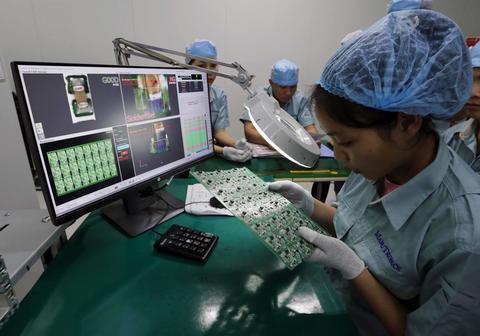
Workers assemble electronic components at Manutronic Viet Nam Joint Stock Company at the Tien Son Industrial Zone in the northern province of Bac Ninh. Electronics, computers and components were among the largest contributors to the country’s exports this year. — VNA/VNS Photo Tran Viet
Vietnamese enterprises’ ability to take part in the global value chain will depend on the quality of their products and a willingness to use advanced technology, speakers saidon Wednesday at the Viet Nam Export Forum 2018 held in HCM City.
Vo Tan Thanh, vice chairman of the Viet Nam Chamber of Commerce and Industry (VCCI), said that local companies must take the initiative in innovation and technology application to meet international standards from buyers.
For markets such as the US, the EU, Japan and South Korea, in addition to general global standards, exporters should be prepared to meet technical trade barriers that could change unexpectedly, he noted.
Viet Nam exports are expected to reach nearly US$240 billion this year, a rise of 10-12 per cent over last year.
With positive export results in the past few months, Viet Nam may end the year with a trade surplus, contributing greatly to economic growth, he added.
The US this year was among the largest export markets with $39 billion, 12.8 per cent higher than the same period last year, followed by the EU with $34.9 billion, up 9.9 per cent and China $32.1 billion, up 21.3 per cent.
Of the 13 free trade agreements (FTAs) the country has signed, 10 FTAs have taken effect. The highly anticipated Comprehensive Partnership Agreement on Trans-Pacific Partnership (CPTPP), which will come into force in December, will open up even further trade opportunities.
Experts attributed the positive export results to administrative reforms and the issuance of certificates of traceability for export products by the Ministry of Industry and Trade.
Although the country is expected to have a trade surplus of $7 billion by the end of the year, it may not be sustainable because of dependence on FDI enterprises, experts said. FDI enterprises account for 70 per cent of the total exports.
In addition, most equipment, technology and raw material exports in Viet Nam mainly depends on imports, accounting for more than 60 per cent. As a result, the export value is not high as it could be.
Export challenges
To Chi Binh, a representative from Bee Logistics Company in HCM City, said that domestic logistics activity was still limited and that Vietnamese enterprises only accounted for 25 per cent of all export companies.
Most domestic enterprises are small scale.
In addition, many Vietnamese businesses have unstable operations, weak customer services, and a low level of innovation, causing loss of customers’ trust, Binh said.
More than 90 per cent of Vietnamese enterprises are small- and medium-sized, while only 21 per cent of them are able to supply goods or services to foreign buyers.
Ron Ashkin, director of USAID LinkSME, said that USAID had recently launched a new five-year $22 million Linkages for Small and Medium Enterprises (LinkSME) project.
LinkSME aims to improve and expand supplier-buyer relationships between Vietnamese and foreign firms.
The project is expected to raise productivity and increase Viet Nam’s capacity to supply products to larger companies both inside and outside the country.
Foreign firms will also reap efficiency benefits from increased local sourcing, he said, adding that LinkSME would help local entrepreneurs up and down the value chain pursue new opportunities and provide new jobs.
Tran Van Cong, deputy director of the Department of Agro-product Processing and Market Development at the Ministry of Agriculture and Rural Development, said the ministry was working with agencies to support export enterprises to meet global standards.
With preferential policies on land investment and value-added and corporate taxes for both domestic and foreign enterprises, the number of investment projects for key exports is expected to increase, he said.
The largest contributors to exports this year included telephones and components with $40.7 billion, up 10.6 per cent; garments and textiles with $25.2 billion, up 17.1 per cent; electronics, computers and components with $24.3 billion, up 15.2 per cent; machinery and equipment with $13.5 billion, up 28.3 per cent; and footwear with $13 billion, up 9.7 per cent.
In addition to manufactured products, earnings for some agricultural and aquatic products also increased during the period.
The Viet Nam Export Forum 2018 was organised by VCCI in association with the American Chamber of Commerce’s HCM City Chapter and the Japanese Chamber of Commerce and Industry. — VNS